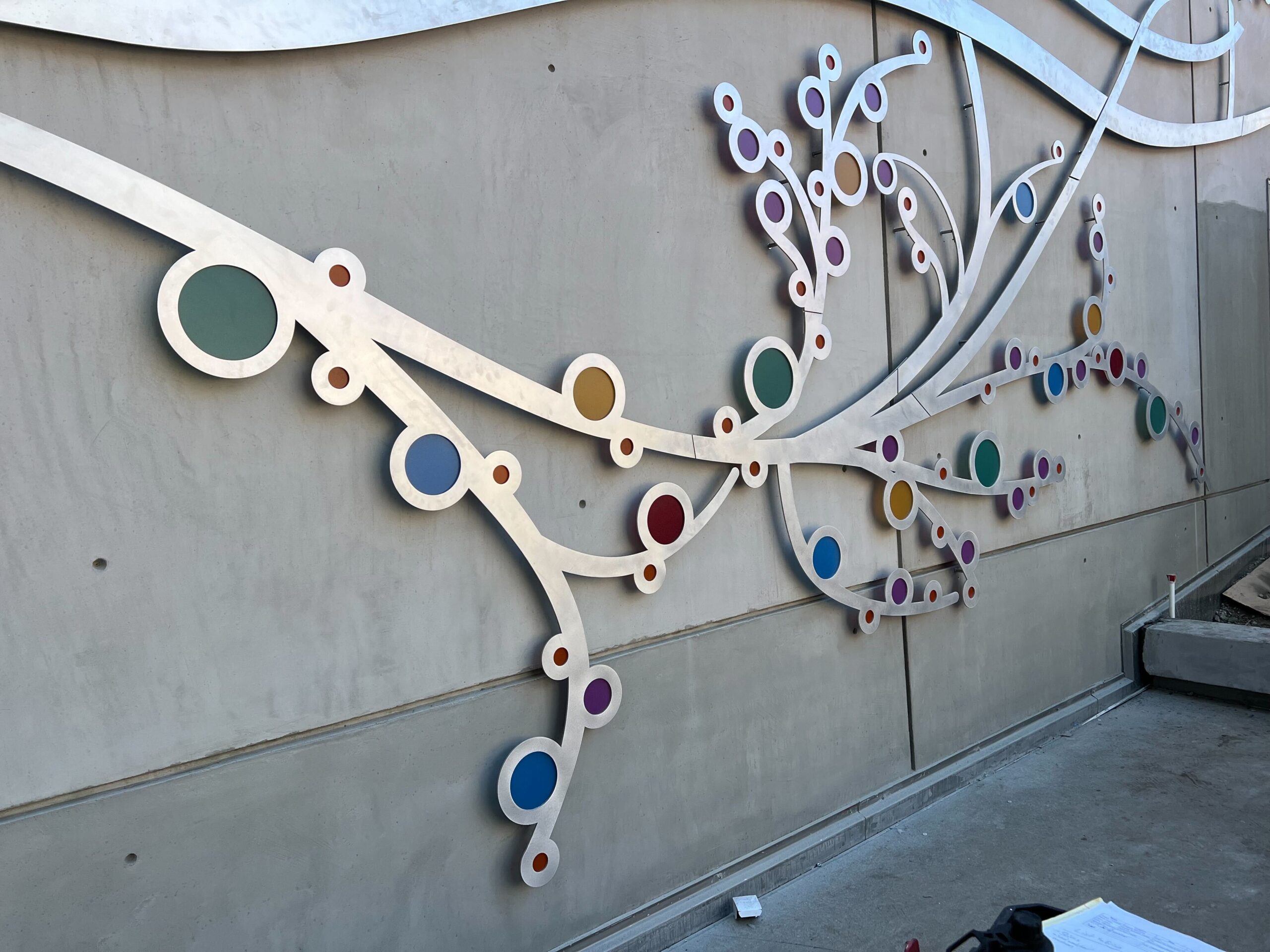This summer Gizmo had the pleasure of fabricating “Uplifting Together” in collaboration with artist Joseph O’Connell, founder and creative director of Creative Machines. As of November 1st, Gizmo successfully completed the installation of “Uplifting Together” at the John Muir Health Hospital in Walnut Creek, CA. This piece will provide guests of the wing a serene view and calming space to inhabit during their visit. The 19 foot high aluminum sculpture sits flat against an outdoor facade of the hospital, and boasts a myriad of colorful orbs at the end of sprawling branches, lit by specialty LEDs.
We were lucky enough to have the opportunity of conducting a Q+A with artist Joseph O’Connell to learn a little bit about some of his inspirations, his life in public art and his experience working as both the fabricator and with a fabricator like Gizmo Art Production.
Read our Q+A with Joseph O’Connell here:
Q: How did you begin as an artist; what were some of your first inspirations?
A: I grew up in a family of makers. Our house was filled with ceramics, motors, music, cooking, sewing, woodworking and welding. My grandfather had been friends with Edison’s youngest son and passed on gadgets from Edison’s workshop. And then when I began my studio, Creative Machines, purely by happenstance I rented a building from Edison’s last shop foreman who filled my head with stories about how Edison would put together teams to tackle problems that were simultaneously technical, social and economic.
I didn’t study art in school. I went to four universities, which before the internet was what you had to do if you wanted to get a lot of different perspectives. I mostly studied history, philosophy, anthropology, literature, music, comparative religion – basically the liberal arts – and that humanistic background is what informs my art to this day.
Q: What have been key points in your career working in public art and creating public art? (This could be when your projects began being public, scale changes, budget or changes in method.)
A: I’ve always made art on a small scale for my personal enjoyment. When I founded Creative Machines in 1995 it was with a mission to “create objects and environments that encourage creativity, support social interaction, and inspire self-confidence.” For almost the first decade we made interactive museum exhibits, but increasingly I wanted to move the experiences that people had with these exhibits away from didactic lessons towards finding their own creativity or exploring ideas. I did some gallery and museum shows early on, but was drawn to the potential for public art to meet people where they really are.
I had built up a lot of tools and skills by that point, so when I started making public art in 2004 I explored a wide range of media. Both the projects and the studio grew organically. Every year we did larger projects and added an average of one member. Around 2010 I started doing large commissions and lately we’ve made some of the world’s largest in categories like human-powered kinetic sculptures, acrylic sculptures, etc.
Q: What has your experience been working with a fabrication company like Gizmo?
A: Working with Gizmo has been wonderful. Until recently, my company has fabricated everything I designed, but we have a certain skill set, certain things we’re good at. Gizmo is good at many things we haven’t tried and it just makes sense to send projects to whomever has experience doing a particular kind of work. We’ve gotten to the point where it is really easy to exchange computer files and photos. I almost feel like I’m right there with the good people at Gizmo.
Q: Longevity and creating long lasting artwork is something both Creative Machines and Gizmo hold dear to our respective missions; what drives your artistic vision towards the permanent vs the ephemeral?
A: Making art is so much work and requires so much attention to detail that I feel we might as well get the most out of that effort. That’s why I almost exclusively create ‘permanent’ pieces. Nothing that humans make is really permanent and the best way to ensure a very long life is to make something people love enough that they’ll restore it and update it with new technology. But something has to stick around long enough for people to start to love it, and that’s where attention to thermal cycling, moisture intrusion, UV degradation, oxidation, etc. come in. We pay a lot of attention to materials at Creative Machines. We have two environmental test chambers to do accelerated testing on materials and we’re always researching new ways to keep our sculptures lasting longer. Gizmo shares that attitude and it has been a pleasure to work with them. I feel confident that Uplifting Together will have a long life.
Q: What do you think of the role of fabricators in public art?
A: Fabricators are collaborators at all stages of the process. Fabricators can provide feedback and ideas during the proposal process, can suggest multiple ways to approach fabrication once a commission has been won, and can deal with unexpected issues as they come up.
Q: What messages do you want to spread about being an artist in this sphere?
A: Anyone can now create public art. The existence of fabricators like Gizmo has made it possible for an artist to come up with a vision and get a commission without needing to know how to build it. As an artist myself, that is a little scary for a moment. But in the bigger picture I think the world is a better place as a result.
Interview conduction by Josefina Sabatino







